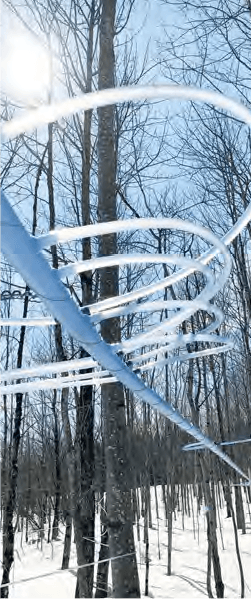Tips from CDL – a healthy tubing system for your sugarbush. Miles Supply is CDL Barre, a CDL store.
excerpted from a previous CDL catalog – see more on CDL site | see page with more tips and this year’s catalog
Which 5/16” tubing to choose?

- CDL FLEX
> FLEX
> Flexible at all temperatures
> The best translucency
> Resists falling trees | No leakage
> Ideal for dropliness
> Excellent elastic memory - CDL VISION
> FLEX / SEMI-RIGID
> Ideal for straight and long laterals
> Good translucency
> Good elastic memory
> Keep its properties over the years - CDL 50
> SEMI-RIGID
> A good compromise of flexibility and rigidity between the VISION and the MAX - CDL MAX
> SEMI-RIGID / RIGID
> Less curvature and better hold in low density sugarbushes
> Ideal for installations where the distance between maple trees is very large
> The least expensive of the 5/16 CDL tubing line
> Interesting quality vs price ratio
The operation temperature of the tubing, determined by altitude, orientation and weather is the most important factor to consider when choosing the color. Do you know the range of temperature in your sugarbush?
The color of the tubing has an impact on the production. We recommend a lighter color like blue or green for a warm bush. Absorbing less UV rays, the tubing won’t overheat and bacteria growth won’t be as fast. For colder bushes, use a darker color like a shadow grey or a dark blue (special order colors) so the line thaws faster. You can use different colors in different locations, with lighter colors for south-facing slopes and darker ones for north-facing sections. Using a different color than the one that is already there is also a good way to easily identify the new sections from older sections. The same principle applies for both mainline and 5/16”.
The see-through property of the tubing is also important to leak check efficiently.
To choose your mainline, you should figure the slope to your sugarhouse, the type of layout (straight or more winding), as well as the type of installation. Think about using the CDL pre-lashed mainline. It does not need to be wire tied, can save you time and labor and provides an easy, one-step installation.
Work less using our precut drops!
Which spout to choose?
There are many types of spouts available. Some are designed to stay in the woods for years, other models are designed to be replaced every year. It is important to make your choice considering the frequency you want to replace them, as well as the level of vacuum you hope to achieve. Some spouts are more suitable for high vacuum systems.
Consider the health of your trees and tap healing when choosing your spouts. The smaller the spout, the smaller the scar in the tree and the faster the healing. So, if your trees are not health and show several scars, consider 1⁄4” spouts instead of 5/16”.
The color of the spout is also important for maximum performance. Did you know that white spouts flow 7% more than black ones? The white ones stay cooler, slowing down bacteria growth. Also, a new spout will always run more than an old one. Source : Acer Center.
It’s been proven that a smaller tap hole (1/4″) doesn’t affect the volume of sap collected under vacuum. Keep your maple trees healthy over the years.
Installation advice
5/16” tubing installation can be done all year long. However, installing in cold weather is harder and slower. Do not overstretch the 5/16” tubing and never stretch mainline because stress in the lines could cause premature aging and breakage in cold weather.
Finding leaks and repairs
The best advice: walk your sugarbush! The time spent inspecting your tubing network will give you better production. Even if you have a CDL monitoring system that helps you find leaks, those leaks won’t fix themselves. It is imperative to know your sugarbush and to spend time walking your lines inside and outside of the sugaring season.
Did you know that each additional inch of mercury (unit of atmospheric pressure) above 23 gives you 5% more sap? Above 26, each inch increases production by 6.33%. Source : Acer Center.
Is it time to replace your tubing?
First, you need to know the age of the tubing and fittings. If you are not sure, consider these key factors in your analysis.
- Have you seen vacuum loss through the years, even with the leaks fixed? If the answer is yes, it means that you have invisible micro- leaks. They are invisible to the eye and impossible to find when you check for leaks because they do not make noise or large bubbles.
Have you noticed that your 5/16” lines sag and don’t stay straight soon after you bind them? If so, it means your tubing has lost most of its original elasticity, meaning it’s getting old…
Have you noticed that some of your mainlines are becoming brittle in the winter? Or that they are hard to clean properly? These 2 factors usually show that it’s time to replace your mainline.
Ideally, do these verifications on a few strategic sections of the sugarbush to evaluate if it’s time to replace part or all of your tubing system.
